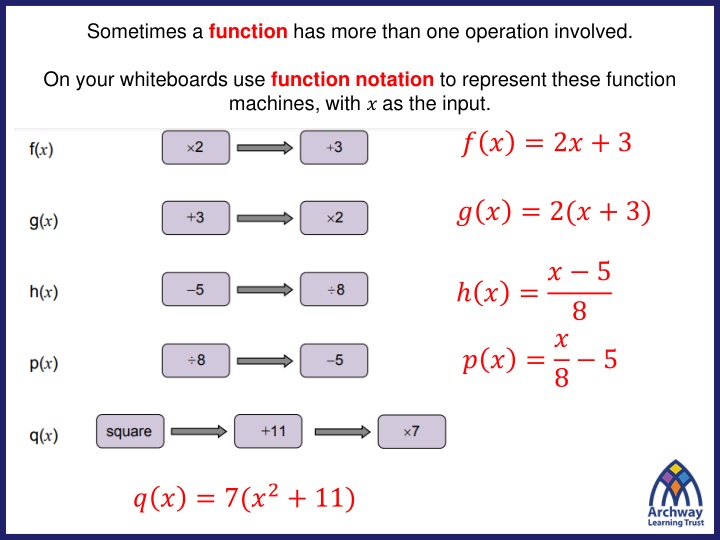
Function Machines and Inverse Operations in Mathematics
Explore the concept of function machines with multiple operations, solve missing values, and learn about inverse operations to reverse functions. Practice writing inverse functions and draw function machines to understand the process better.
Download Presentation

Please find below an Image/Link to download the presentation.
The content on the website is provided AS IS for your information and personal use only. It may not be sold, licensed, or shared on other websites without obtaining consent from the author. If you encounter any issues during the download, it is possible that the publisher has removed the file from their server.
You are allowed to download the files provided on this website for personal or commercial use, subject to the condition that they are used lawfully. All files are the property of their respective owners.
The content on the website is provided AS IS for your information and personal use only. It may not be sold, licensed, or shared on other websites without obtaining consent from the author.
E N D
Presentation Transcript
Sometimes a function has more than one operation involved. On your whiteboards use function notation to represent these function machines, with ? as the input. ? ? = 2? + 3 ? ? = 2(? + 3) ? =? 5 8 ? ? =? 8 5 ? ? = 7(?2+ 11)
? ? = 2? + 3 ? ? = 2(? + 3) ? =? 5 8 ? ? =? 8 5 ? ? = 7(?2+ 11)
Work out the missing values How did you calculate the missing input B?
To reverse the process of a function (go from the output to the input) inverse operations are used. ? ? The inverse function here would be written like this: ? 1? = 9 ? 7
On your whiteboards: Add 7 Divide by 9 9 7 What are the missing inverse operations? How do we write the inverse function? ? 1? = 9? 7
On your whiteboards: 5 +1 2 What are the missing inverse operations? How do we write the inverse function? ? 1? =? + 1 5 2
On your whiteboards: ? ? What are the missing inverse operations? How do we write the inverse function? ? 2 5 ? 1? =
In your books: Draw the function machines for each function and use it to work out the inverse function ? ? = 5? + 2 ? = 5? + 2 ? ? = ? + 2 ? = 5(? 2)2 ? ? = 5(? 2) ? ? = ? 2 ? =2? + 5 ? ? = 2? + 5 ? ? = 2? 3 ? ? =? ? 2 5 ? ? =? 2 5 ? = 3 2 ? =?2 3+ 5 ? ? = ?2 ? ? = ?2+ 5
Mark and correct your work ?2 2 5 ? 2 5 ? 1? = ? 2 1? = ? 1? = ? 1? = ? + 2 ? 5+ 2 ? 5+ 2 1? = ? 1? = ? 1? =? 3? 5 2 ? 5 5 2 1? = ? 1? = ? 1? = 2? 1? = 2(? ? 1? = 2 ? + 5 3+ 5) ? 1? = 1? = ? 1? = ? 5 3(? 5) ?
What is the inverse function? ? + 1 ? 2 ? ? = Drawing a function machine is not always possible
Worked Example If ? ? =?+1 ? 2, find ? 1(?). STEP 1: Write the output ?(?) as ? ? =? + 1 ? 2 This is purely for convenience. ?? 2? = ? + 1 STEP 2: Get the input in terms of the output (make ? the subject). ?? ? = 1 + 2? ? This is because the inverse function is the reverse process, i.e. finding the input ? in terms of the output ?. ? ? 1 = 1 + 2? STEP 3: Swap ? back for ? and ? back for ? 1? . ? =1 + 2? ? 1 This is because the input to a function is generally written as ? rather than ?. ? 1? =1 + 2? ? 1
Check Your Understanding Your Turn ? If ? ? =2?+1 If ? ? = 2? 1, find ? 1(?). 3, find ? 1(?). ? ? =?? + ? ? = ?? ? ? ??? ? = ? ?? = ?? + ? ??? ? = ? ? ?? ? = ?? ? ? ?? ? = ? ? =?? ? ? ? ? = ?? ? ? ?? =?? ? ? ? ? ?? = ?? ?
In your books Find ? 1(?) for the following functions. Find ? 1(?) for the following functions. ? ? + 3 ? ? =? 2 ? ? ? =2? 1 ? 1 1 ? 3? + 1 3? 3 + 2? 1 3 a ?? a b c ? ?? = ? ? = ? ? = 5?? ?? =? ? ? ? ? ? ? b ? ?? = ? ? ? ? ? = 1 + ? ? ? = 6? 4? ?? =?+? ? ? =?+7 ? ?? = ? d ? c ? ?? =? ? 3? ?? = ?? ? ? ? = 5 ? + 1? ?? = ? ? = 10 3?? ?? =?? ? e ? ? ? ? ?? + ? ?? ? ?? ? ? ? ? d f ? ?? = ? ? = ? e 2 ? ?? = ? ? = 2? ? ? = ? 1 ? Find ? 1? ? = ? ?
